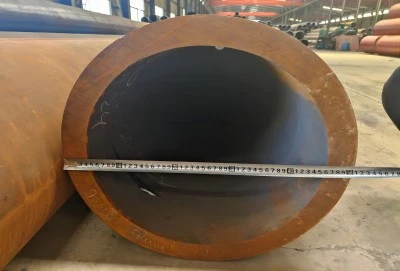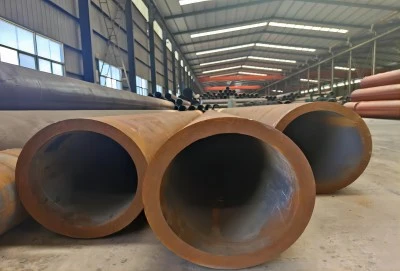To enhance their longevity and performance in diverse environments, EN10210 pipe requires protective coatings. Longma's article explores the various coatings used on these pipes, focusing on their properties, application methods, and benefits.
EN 10210 pipes are hot-finished structural hollow sections made from non-alloy and fine grain steels. While these pipes possess inherent strength and durability, they can be susceptible to corrosion and other forms of environmental degradation when exposed to harsh conditions. Protective coatings serve as a barrier between the steel surface and the surrounding environment, significantly extending the service life of the pipes and maintaining their structural integrity.
|
|
|
Galvanizing:
Galvanizing is one of the most widely used and cost-effective methods of protecting steel pipes, including EN10210 pipes, from corrosion. This process involves coating the steel surface with a layer of zinc, which acts as a sacrificial anode to protect the underlying steel from corrosion.
There are two main methods of galvanizing EN 10210 pipes:
1. Hot-dip galvanizing: In this process, the steel pipe is immersed in a bath of molten zinc at a temperature of around 450°C (842°F). The zinc reacts with the steel surface, forming a series of zinc-iron alloy layers, topped with a layer of pure zinc. This method produces a thick, durable coating that can provide long-lasting protection.
2. Electrogalvanizing: This process involves electroplating the steel pipe with zinc in an electrolyte solution. While it produces a thinner coating compared to hot-dip galvanizing, it offers excellent uniformity and is often preferred for pipes that require tight dimensional tolerances.
It's worth noting that while galvanizing provides excellent corrosion protection, it may not be suitable for all applications. In highly acidic or alkaline environments, or where the pipes will be exposed to certain chemicals, alternative coatings may be more appropriate. Additionally, if the pipes are to be welded after galvanizing, special considerations must be made to protect the welded areas from corrosion.
3PE Coating:
3PE (Three-Layer Polyethylene) coating is an advanced protective system commonly used on EN10210 pipes, especially for underground and underwater applications. This coating system provides superior corrosion protection and is particularly effective in harsh environments where pipes are exposed to moisture, chemicals, and abrasive materials.
3PE Coating System
1. Fusion Bonded Epoxy (FBE) Layer: This is the first layer applied directly to the steel surface. FBE provides excellent adhesion to the steel and offers good chemical and corrosion resistance. The typical thickness of this layer ranges from 150 to 300 microns.
2. Adhesive Layer: The second layer is a copolymer adhesive that acts as a bridge between the FBE and the outer polyethylene layer. This layer ensures strong bonding between the different materials and typically has a thickness of 150 to 300 microns.
3. Polyethylene Layer: The outermost layer is made of high-density polyethylene (HDPE) or medium-density polyethylene (MDPE). This layer provides mechanical protection, resistance to soil stress, and serves as a barrier against moisture and chemicals. The thickness of this layer can range from 2 to 3.5 mm, depending on the pipe diameter and project requirements.
The 3PE coating system offers several advantages for EN 10210 pipes
- Excellent Corrosion Protection: The multi-layer system provides a robust barrier against corrosive elements, significantly extending the service life of the pipes.
- High Impact Resistance: The outer polyethylene layer offers superior resistance to mechanical damage during handling, transportation, and installation.
- Chemical Resistance: 3PE coatings are resistant to a wide range of chemicals, making them suitable for various industrial applications.
- Temperature Resistance: Depending on the specific materials used, 3PE coatings can withstand operating temperatures from -40°C to 80°C (-40°F to 176°F).
- Long-term Performance: When properly applied, 3PE coatings can provide protection for decades, reducing maintenance costs and the need for pipe replacement.
- Flexibility: The coating system can accommodate pipe movements and soil stresses without cracking or disbonding.
When specifying 3PE coatings for EN10210 pipes, it's important to consider factors such as the specific environmental conditions, operating temperature range, and any potential chemical exposures. The coating thickness and specific materials may need to be adjusted based on these factors to ensure optimal performance and longevity.
Black/Whitening:
The term "black/whitening" in the context of EN 10210 pipes can refer to two distinct surface conditions, each with its own characteristics and applications. Understanding these treatments is important for specifying the appropriate pipe finish for a given project.
Black Pipes
"Black" pipes, also known as "black steel" pipes, are essentially EN10210 pipes that have not undergone any specific coating process. The term "black" refers to the dark, oxidized surface that naturally forms on the steel during the hot-finishing process. This surface layer, often called mill scale, consists primarily of iron oxides.
White Pipes
The term "white" or "whitened" pipes typically refers to EN 10210 pipes that have undergone a simple surface treatment to remove the mill scale and provide a cleaner, brighter appearance. This process is often referred to as "pickling" or "descaling."
When specifying EN 10210 pipes, the choice between black and white finish should be based on factors such as: - Environmental exposure - Aesthetic requirements - Need for additional coatings - Welding requirements - Cost considerations - Regulatory compliance (e.g., food-grade applications)
In some cases, project specifications may call for "pickled and oiled" pipes, which undergo the whitening process followed by a light oil coating to provide temporary rust protection during transportation and storage.
China EN10210 Pipe Factory:
Longma, a leading manufacturer based in China, specializes in the production of high-quality EN10210 pipes. With years of experience and a commitment to excellence, Longma has established itself as a trusted supplier in the global market for structural steel pipes.
Longma's coating capabilities include galvanizing, 3PE coating, and various surface treatments, allowing them to offer EN10210 pipes suitable for a wide range of environmental conditions and project requirements. Their team of experts can provide guidance on selecting the most appropriate coating for specific applications, taking into account factors such as corrosion resistance, mechanical protection, and cost-effectiveness.
For those in search of reliable EN10210 pipe manufacturers, Longma welcomes inquiries and consultations. Their team of experts is ready to assist with product selection, technical specifications, coating options, and customization possibilities. Interested parties can reach out to Longma at info@longma-group.com for more information about their products, capabilities, and how they can meet specific project needs.














